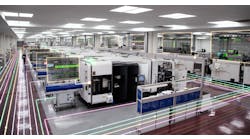When Carlo Miceli, president of Miceli Technologies Inc. (www.miceli-technologies.com) and his engineering design team set out to create a new CNC machine tool controller six years ago, they set out to raise the performance bar and change the entire paradigm of what a machine tool controller should be.
Six years later they believe they have succeeded, and they say that their MTI controller drives machine tools twice as fast and twice as efficiently as other controllers on the market.
“Our goal was to develop a controller that truly gives the user a competitive advantage,” Miceli said.
“We also wanted to keep it simple. One of our early reviewers said our controller has a ‘Honda feel’ to it, meaning that it is slick, simple and has a natural, intuitive feel to it. It doesn’t frighten people with 200 push buttons, 90 percent of which never get used. And it drives machine tools at a constant velocity that is at least twice as fast as the other controllers,” he added.
Miceli and his team build the controller from the ground up using computer architecture that is different from the architecture used by the rest of the industry.
“The controller is a delicate balance that uses existing mainstream computer technology with proprietary components, but in a completely different and unique architecture,” Miceli said.
The controller has two separate operating environments – one for the machine operator and the other for the machine itself.
The operator environment uses the Windows XP Pro operating system to enable applications that run under Windows XP to be run on the controller without interfering with what is going on in the machine environment.
A machine operator can be answering email, using a Computer Aided Machining package to generate toolpaths and post process into G-code, or playing solitaire while the machine is running a different program and cutting metal. Unlike other controllers that use a single microprocessor to service both environments, the MTI controller has two completely separate microprocessor systems.
What is most important about the MTI controller’s architecture is that it can process data as much as 25 times more efficiently than all other controllers. Data is processed by a controller in blocks, and the speed of a controller can be measured in how many blocks of data can be processed per second.
The current industry average is about 2,000 blocks per second with a low of about 600 blocks per second and a high of less than 6,000 blocks per second when doing 3-axis applications.
The MTI controller can process as many as 150,000 blocks per second in a 3-axis application and 50,000 blocks per second in an 8-axis simultaneous application.
Miceli uses an analogy of a car driving along a twisting mountain road for the first time to explain the impact of that increased processing capability.
“With other controllers it is like the driver of the car has to go slowly while he looks ahead to see how the road is twisting and turning, but with our controller the driver immediately and completely knows the entire road before he even turns the car’s ignition on,” he said.
Analogies might help understand the potential, but the proof is in the actual machining. The MTI controller consistently drove a machine tool running the Mercedes test twice as efficiently and cut the cycle time in half. The Mercedes test was developed by Mercedes Benz as a standard test of complex machining, and it is used to compare the performance of different machine tools.
“The more complex the parts being cut, the more efficient our controller is,” Miceli said.
Miceli offered an explanation for the reason that a machine tool equipped with his controller is only twice as efficient as other controllers when it can process data as much as 25 times faster.
“The fact is that, until now, the limiting factor in machine tools has been the electronics controlling the tool. In general, machine tools have always outpaced the controller electronics available to manage the tools. Drives and motors also are way ahead of controller technology. The reason that our controller operates so much faster than other controllers — but we only get twice the efficiency and half the cycle time — is because for the first time we have a controller that has the potential to drive a machine faster than current machines can go,” he said.
“If a tool design engineer can figure out a way to make a machine cut 10 times faster than the current machines can, then our controller is already waiting to drive it,” he added.
Miceli said other controller companies are using old architectures that their engineers are used to working with.
“Even the newer controllers were designed by engineers who are used to working with the old architectures. Like most product development today, controller designers are looking to add more bells and whistles to existing architecture rather than find a faster, more efficient and simpler architecture.
“If you are an established company with a product that has been successful for 20 years or more, then that makes sense. But if you are a new company, such as ours, then our need is to innovate in order to differentiate, and that is exactly what we have done. The net result is that any machine using our controller will be twice as efficient and take half the cycle time as the same machine cutting the same part using any other controller,” Miceli said.
At the moment, the MTI controller is available only on the GBI Cincinnati Inc. (www.gbcincinnati.com) Revolution CV4020 machining center, but Miceli is talking with other machine tool makers and hopes that the MTI controller will have wider implementation in the near future. The MTI controller will be demonstrated at IMTS 2008 at the GBI Cincinnati Inc.






